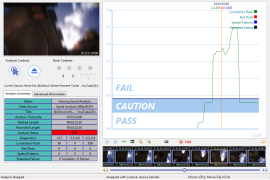Open letter to the BioShock creative team
Posted: 04/18/2013 Filed under: Photosensitive Seizure Prevention, Results of safety testing, Seizure Warnings, Video Game Companies | Tags: BioShock, computer games, flash, flicker, photosensitive epilepsy, seizure warning, seizures, video games Leave a comment Congratulations on last month’s successful launch of BioShock Infinite. The reviews are extraordinary. BioShock Infinite is said to set a new standard for what the video game experience can be. Players are moved and enthusiastic about many aspects of the game and speak effusively about their unprecedented degree of involvement with the story and characters. With all the creative energy, care, and respect for players that went into developing BioShock, though, the game–like so many others–exposes players to visuals that can cause seizures.
Congratulations on last month’s successful launch of BioShock Infinite. The reviews are extraordinary. BioShock Infinite is said to set a new standard for what the video game experience can be. Players are moved and enthusiastic about many aspects of the game and speak effusively about their unprecedented degree of involvement with the story and characters. With all the creative energy, care, and respect for players that went into developing BioShock, though, the game–like so many others–exposes players to visuals that can cause seizures.
I examined several BioShock launch trailers and some other “footage” – a total of eight clips of a few minutes each – and assessed them using an application that identifies video sequences that can trigger seizures. Most of the material was fine, but three of the clips contained brief flashing sequences that don’t meet criteria for safe viewing. It doesn’t take more than a brief exposure to trigger seizures in those who are vulnerable.
Contrary to what many gamers assume, eliminating seizure triggers doesn’t make a game boring to look at or play. Irrational Software created a visually stunning, highly engaging experience in which most of the scenes don’t pose a seizure risk. Reports of video game-induced seizures began surfacing in 1981 in newspapers and medical journals. A great deal is known about what types of images and sequences can provoke seizures.
Guidelines for seizure-free video sequences were developed in the UK more than 20 years ago. Since 1991 all television programming and commercials there are required to pass a seizure-safety test. Japan put in place a similar measure following the 1997 Pokémon broadcast that led to hundreds of seizures. In 2005 the International Telecommunication Union published recommended universal guidelines for reducing photosensitive seizures from televised material.
While all these efforts were made to reduce the risk to consumers of photosensitive seizures, video game publishers took their own action—providing printed seizure warnings. The warnings began appearing in the early ‘90s, after a few consumers filed personal injury lawsuits. Putting a seizure warning on video games has thus far provided legal cover for your industry, but offers little protection for customers.
The warnings all state that photosensitive seizures happen to “a very small percentage of people.” Seizures from flashing images are not rare, but people believe they are because that’s what the warnings say! The wording of these warnings is based on researchers’ estimates that were made decades ago, before today’s sophisticated graphics and before more recent studies that suggest that many photosensitive seizures could be going completely unnoticed. Many doctors continue to think these seizures are rare because that’s what they were taught.
If you haven’t heard many reports of seizures happening while playing BioShock, don’t assume the seizures aren’t occurring. They’re just not being identified. A person experiencing seizures is likely to lose awareness and not even realize what’s happening, or notice that a bit of time has passed that they can’t account for. Furthermore, most seizures don’t involve convulsions, and the only sign others might see could be as subtle as a short period of staring.
Whether or not a seizure is noticeable, it’s a serious event with real risks to health. It can impair health, thinking, and behavior for days afterward. Sometimes a seizure results in permanent disability.

But this screen capture from the Harding Flash and Pattern Analyzer shows that flash in the BioShock sequence shown at upper left failed seizure safety guidelines.
It’s not reasonable to expect parents to continually monitor their kids for possible signs of a seizure, particularly given that video games are played while people face a screen. So let’s turn to older teens and adults in the midst of a game, who might theoretically be more self-aware and responsible for their own well-being. Will they be vigilant for seizure symptoms such as odd sensations or altered consciousness?
Just last month in a New York Times interview your creative director Ken Levine said, “We work really hard to wear down the audience’s ability to even process. If players are immersed enough, they stop treating it as a piece of artifice and just start experiencing it.” Do you see the problem here? In this ideal game experience, how can players be expected to “immediately stop playing and consult a doctor” as the warning advises, if they develop symptoms consistent with a seizure?
With BioShock Infinite now brought to market, people are asking what your company will do next. You could easily raise the bar further for the industry by publicly committing to developing seizure-safe games. I live in the Boston area and would welcome the chance to begin a conversation about this at your headquarters in Quincy.


